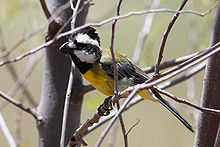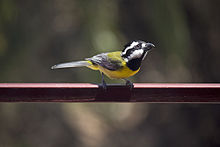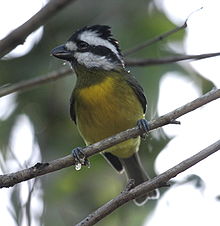- Crested Shrike-tit
-
Crested Shrike-tit 
Male Conservation status Scientific classification Kingdom: Animalia Phylum: Chordata Class: Aves Order: Passeriformes Suborder: Passeri Family: Pachycephalidae Genus: Falcunculus
Vieillot, 1816Species: F. frontatus Binomial name Falcunculus frontatus
Latham, 1802The Crested Shrike-tit (Falcunculus frontatus) is a bird endemic to Australia where it inhabits open eucalypt forest and woodland.
Contents
Taxonomy and distribution
Recent work with nuclear gene sequencing suggests that the shrike-tits and the Wattled Ploughbill may require their own family, Falcunculidae (Dickinson 2003). There are three subspecies (sometimes considered full species) with disjunct ranges:[2][3]
- Western Shrike-tit (F. f. leucogaster) - sparsely distributed in south-western Western Australia
- Northern Shrike-tit (F. f. whitei) - rare, with isolated records in the Kimberley region of north-western Australia and the Top End of the Northern Territory
- Eastern Shrike-tit (F. f. frontatus) - the stronghold of the species in south-eastern Australia from the Lower South-East of South Australia, coastally and in the Murray-Darling Basin to south-eastern Queensland, with some scattered occurrences further north and west in Queensland
Description
Males are larger than females in wing length, weight, and bill-size.[4] Males have black throats, while females have olive green.
Behaviour
It feeds mainly on insects, spiders and, sometimes, particularly during the breeding season, young birds. Thistles are also taken. It has a parrot-like bill, used for distinctive bark-stripping behaviour, which gains it access to invertebrates.
Status and conservation
The Eastern Shrike-tit is evaluated as being of Least Concern on the IUCN Red List of Threatened Species, the Northern Shrike-tit is considered Endangered, and the Western Shrike-tit is listed as Near Threatened.[1] Both the Northern and Western Shrike-tits suffer from habitat loss and fragmentation.[5]
References
Notes
- ^ a b "Falcunculus frontatus". IUCN Red List of Threatened Species. Version 2011.2. International Union for Conservation of Nature. 2009. http://www.iucnredlist.org/apps/redlist/details/106005629. Retrieved 12 November 2011.
- ^ Higgins & Peter (2002)
- ^ Higgins, P. J.; Peter, J. M. (2002). Handbook of Australian, New Zealand and Antarctic Birds. Vol.6: Pardalotes to Shrike-thrushes (1. publ. ed.). Melbourne: Oxford University Press. pp. 1050–1063. ISBN 0-19-553762-9.
- ^ Noske, Richard (2003). "Does the crested shrike‐tit Falcunculus frontatus exhibit extended parental care?". Corella 27: 118–119.
- ^ West, Judy. "Water for a Healthy Country". Commonwealth Scientific and Industrial Research Organisation. http://www.csiro.au/files/files/pbtx.pdf. Retrieved 12 November 2011.
Sources
- Del Hoyo, J.; Elliot, A. & Christie D. (editors). (2007). Handbook of the Birds of the World. Volume 12: Picathartes to Tits and Chickadees. Lynx Edicions. ISBN 9788496553422
- Dickinson, E. C. 2003. The Howard & Moore Complete Checklist of the Birds of the World. 3rd Ed. Princeton University Press, Princeton, N.J.
- Schodde, R. and I. J. Mason. 1999. Directory of Australian Birds. Passerines: i-x, 1-851. CSIRO Publishing, Canberra.
External links
This Pachycephalidae-related article is a stub. You can help Wikipedia by expanding it.



